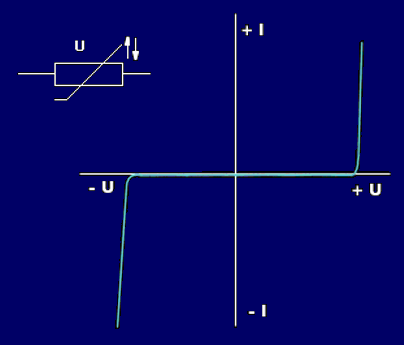voltage dependent resistor (VDR)
The term varistor, Voltage Dependent Resistor (VDR), is a neologism of Variable Resistor. A varistor is a voltage-dependent resistor that has a relatively high resistance over a defined voltage range. This drops abruptly towards zero at a certain voltage. This applies equally to positive and negative voltages, which have identical limiting values. The I-V characteristic is therefore symmetrical for both polarities.
Varistors are constructed in sandwich technology, with sintered silicon carbide( SiC) or zinc oxide( ZnO) between two electrodes. Functionally, the varistor is a semiconductor. It consists of many bidirectional diodes connected in parallel and operated in the reverse direction. When an electric field is applied, the junction layers degrade. This effect occurs during sintering at the junctions of the zinc oxide particles. The overvoltage level increases with the thickness of the sintered layer, and the leakage current increases with its size.
Varistors are used for voltage limiting and voltage stabilization in electrical and electronic circuits. They serve as overvoltage protection in that they protect electronic circuits from overvoltage and thus from damage. Depending on the design, varistors can be designed for a few volts, but also for several hundred volts.
Special multilayer varistors such as the metal oxide varistor have been developed for overvoltage protection and for dissipating electrostatic discharges. They are characterized by their robustness against overvoltages and their fast response.

